Wherever there are businesses, dozens of web designers will be fighting to win them as clients. Unfortunately, way too many business owners sink a lot of hard-earned capital into what turns out to be series of bad ideas—executed badly.
So, exactly how does a business owner get online without getting burned? To answer that question, we need to examine the industry.
To begin with, anyone can call him or herself a web designer. There are plenty of educational opportunities—colleges, certifications, online study… …you name it. However, most web designers teach themselves and quickly succumb to their own bad ideas.
It’s easy to be taken in by a web designer who uses all the right words, and confidently explains how their design is your ticket to online abundance. Sadly, their path down the information superhighway way too often turns out to be a World Wide Waste.
Your first line of defense should be developing an understanding of the Internet landscape and how various elements fit together. You don’t have to be a web designer to know the kind of online experience your customers expect. Mostly they want information, and they want it right now.
So, give it to them—right now. Web designers love to design. As a result it’s easy for them to put their priorities ahead of yours. They’ll propose all sorts of things that seem really cool, but come at the expense of page speed. Recent data shows that users will give you 2.6 seconds to decide whether or not they like your page. If that page takes more than 2.6 seconds just to load…
The best way to illustrate that is to experience it…
We've all experienced award winning websites that are miserably slow to load. The designer and the owner of the business are no doubt very proud of the online spectacle that’s been created. Everybody loves it…
…Except customers. They simply give up and move on to a competitor’s website that’s less frustrating.
The designer missed the mark because the designer’s priorities were given preference over the needs of the customer. It happens all the time.
Often, the designer simply has weak skills or obsolete ideas. A good web designer won’t ask you to live with website “quirks.” Everything should work exactly as you or your visitors expect. The entire user experience—as a customer as well as site administrator—should be natural, obvious and error-free.
Web technology moves fast. It is easy for a web designer to become out of step with the latest standards and best practices. This is particularly true with online search, or SEO. Many methods that were standard practice two or three years ago, can get your website de-indexed today. “De-indexed” basically means getting kicked off the Internet.
Spend some time researching current sources, including Google’s own documentation, to learn about SEO. You’ll not only feel empowered, but will likely learn many so called experts aren’t experts at all.
Most web designers have a poor understanding of business fundamentals. For this reason, the best “web designer” is usually a web agency with experts in consumer behavior, product positioning, conversion path optimization, engineering, security, and other critical business areas.
Web design doesn’t have to be expensive. It just has to be right. Your business and your sanity depend on it.
If you have questions, don’t hesitate to call or drop us a note.
 When you work in a web design company, in digital marketing, or in SEO, Google Algorithm updates are often a trigger for mild panic attacks. You hold your breath as you start to see the effects of the change. You cry a little if your traffic starts to tank, or you jump for joy if your traffic sees a large rise. The good news, though, is Google’s Penguin 4.0 signal change might just work as well as a meditation ritual for reducing your stress.
When you work in a web design company, in digital marketing, or in SEO, Google Algorithm updates are often a trigger for mild panic attacks. You hold your breath as you start to see the effects of the change. You cry a little if your traffic starts to tank, or you jump for joy if your traffic sees a large rise. The good news, though, is Google’s Penguin 4.0 signal change might just work as well as a meditation ritual for reducing your stress.
Google’s Penguin signal has been focused on the effects of spammy links since 2012. Like the rest of the internet, the signal has evolved a lot since its original release - and for the better. The largest complaint for prior Penguin versions was the intermittent and inconsistent penalization of bad links.
As it ran the Penguin algorithm in waves, Google only assessed and removed website penalties periodically. Meaning, if you were a site that had disavowed your bad links, you may not see any removal of your penalty for several weeks or even months down the road. Your site’s rankings, in the meantime, we're still being penalized. In your web design and content strategy, you then were stuck waiting for Google’s next wave before you saw results of the positive work you had done since the disavowal.
Painful timelines aside, Google’s older Penguin versions also implemented a one-size-fits-all policy towards spam links. If you received link penalties on one page, your entire domain was penalized in the rankings. Now this small problem, on top of the long timeline before your penalty could be removed, became a massive migraine for web design companies and strategists.
Penguin 4.0 was slowly released throughout the fall of 2016, and has now been made core to Google’s algorithm. The new release, deemed the ‘Real Time’ update, seeks to expedite the link penalty process. Operating in almost ‘real time’, Google will now assess and remove penalties for websites much more quickly. If you have a poor web design company who with many spammy links, this update may have killed your traffic. Sorry. While you previously may have been able to go for longer periods before penalties were assessed to your site, this is no longer going to fly with Google. If you have a great web design company and a solid set of credible and clean backlinks, it’s your turn to jump and cheer. Google can now reward your good behavior by quickly decreasing the rankings of sites with spammy links, thereby increasing your rankings. Free traffic without additional effort - just for doing the right thing in your web design to start with!
Penguin 4.0 also removed the one-size-fits-all policy and removed the automatic penalty to the entire domain. Now, Google will not confirm that this means only the page that the link appeared on will be penalized. But, it is likely that your entire website and rankings will not be penalized for one page with bad links. Google also has become smarter and more selective around reviewing and interpreting your links. For example, if your website is in an industry where spammy links are plentiful across competitors, rather than knocking all of these website’s rankings, Google may just decrease the weight of the links in its ranking algorithm. This is just one part of how Google has become more semantic and understanding of the subtleties of linking strategies that a web design company uses.
The trick to adapting to Google’s changes and staying on top of your rankings is often by utilizing a creative Reno web design company. With a full-time team of designers, developers, and strategists, a web design company can stay in the loop with Google’s changes. They can also keep your site and link strategy evolving with the Penguin releases. OCG Creative provides a full team to help you with Reno web design, content strategy, SEO, and ongoing internet marketing initiatives. Call us. We’d love to help. (775) 324-1644
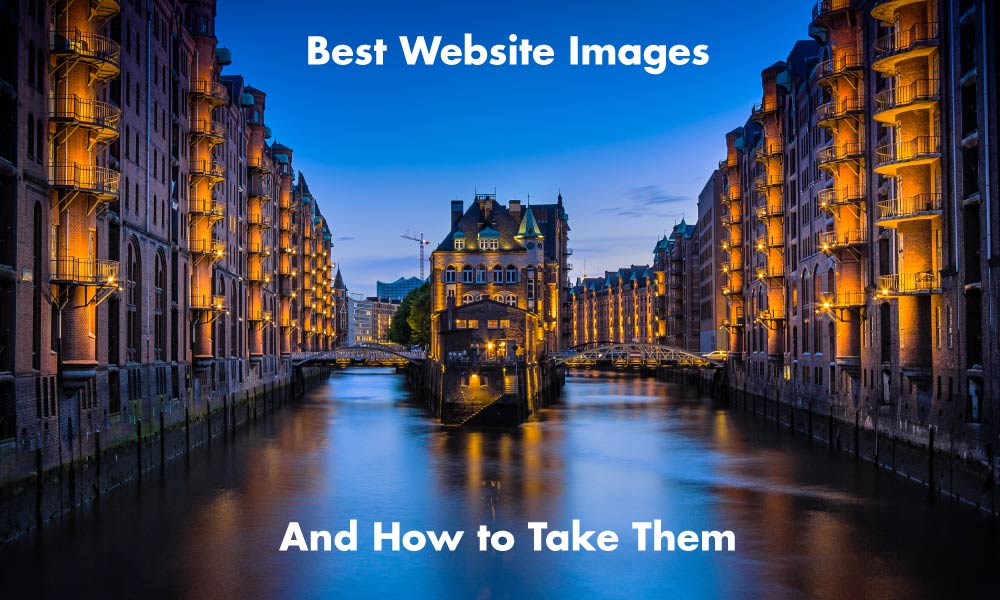
The best creative web design for clients all have one thing in common; image quality. Images are the number one visual way information is communicated and in the day and age of increasing demands for quick information, images do a great job at telling a story quickly for site visitors. Images are crucial for efficient web design because they break up content on pages which can be overwhelming for visitors. Essentially, people want information fast, and when they don’t get the answer to a search phrase, they leave the site (contributing to high bounce rates, low conversions, and lowered SEO scores). What better way to convey information quickly than through pertinent images paired with good keyword-heavy content aiming to match a visitor’s search phrase?
Efficient use of images can be hugely beneficial to a site and can add to a business’s branding, their tone toward visitors, their business’s image, efficiency in converting visitors, guiding efficient site-navigation, SEO, and much more. Images work hand in hand with creative web design and are increasingly recognized in their importance in conveying information:
“A common finding is an observed processing superiority of pictures as compared to words, suggesting that pictures have a faster and more direct access to meaning, while words are discussed to require additional translational activity...” -Schlochtermeier, et al. (2013).
Given the importance of images to visitors, it is good to know what constitutes as good images for a website to make the most of creative web design.
When people think of the best web design they typically only think of a site’s layout. However, most people forget that a large portion of layout is where to place high-quality images and content. The best web design is unique for each client and their business. However, there are similarities with site layouts and how images are arranged:
Simple and effective designs use layouts with images that do not confuse visitors, help them navigate the site, sell your unique message, and help convert visitors into a customers. Good layouts also use images to guide visitors toward pertinent pages or locations on their site.
There is a misconception that images need to be small for a website. Images need to be as big as possible to get high resolution, only their file sizes need to be small. Thankfully OCG takes care of all file compression so even if you give us massive photos, we ensure they are optimized on your website. Images that are too small are 'pixelated' or 'low-res' and look bad on websites and can hurt your online appearance and brand identity.

High Res Image

Low Res Image
The images need to be well lit. Avoid using a flash because it tends to wash out all images. The main source of lighting should not be behind the subject either and you should avoid highly contrasted images that add a lot of distracting patterns. This is very important because many images on a website have text over them and high-contrast images make it difficult to read the content and can be strenuous to look at on their own.

Good Lighting

Bad Lighting
Having everything in focus can make the image too cluttered and distract from what you really want to viewer to see in the image. A ‘soft-focus’ pulls the viewer’s eye toward the object you want site visitors to pay attention to while softly blurring the rest. This can also help de-clutter busy images.

Good Focus

Bad Focus
Many people think that if you want to draw attention to something it needs to be centered in the image. That can get repetitive with many images on your site. Take images from close up and far away with the subject in different places. It can be a mistake to take all of your images from one perspective using one composition, unless you are taking product shots.

Good Composition

Bad Composition
You may hear web-designers or account-coordinators talking about ‘mastheads’. Mastheads, banners, or site headers are the images that display at the top of each web page. These images need to be large (to work with a responsive website) and need to be ‘landscape’ not ‘portrait’. Additionally, because visitors only see a tiny part of the whole image, it is a good idea for the image to capture 'depth’. For example, instead of taking images from a top-down angle on a subject, try taking shots from different angles that emphasize perspective. A good way to do this is taking a series of images starting from the ground-level and moving up.

Good Perspective

Bad Perspective
Many clients find sites and ask what we can do to make their site more like the example they choose. The most common site people tend to ask for is Apple or other sites for technology companies. So what do they do that makes their layout work so well?
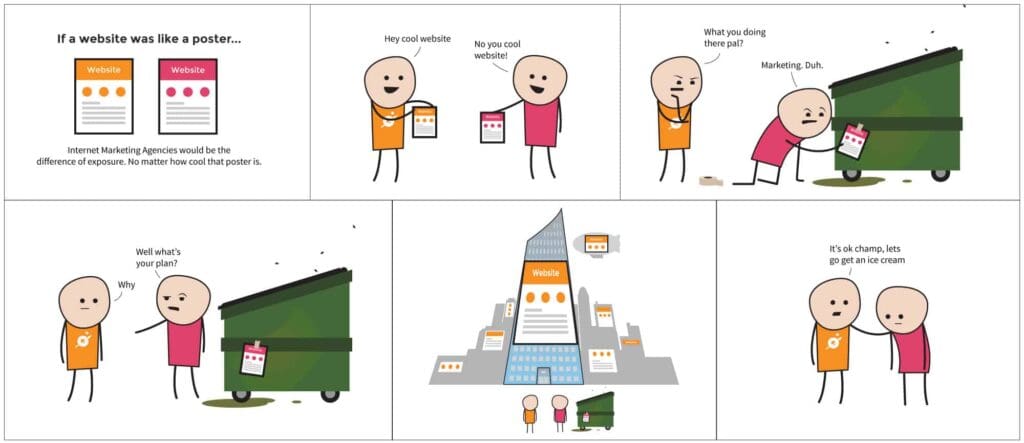
Creativity reigns supreme right? It is common knowledge that only the coolest websites get top exposure. Part of me, as a web designer, hopes this would be true. However, creative web design only takes a business so far. Ultimately, there are thousands of terribly designed websites that get more traffic than award-winners. If you want your website to work for you beyond a cocktail party talking point, then you need to know that Web Design is a part of Internet Marketing and not the same thing.
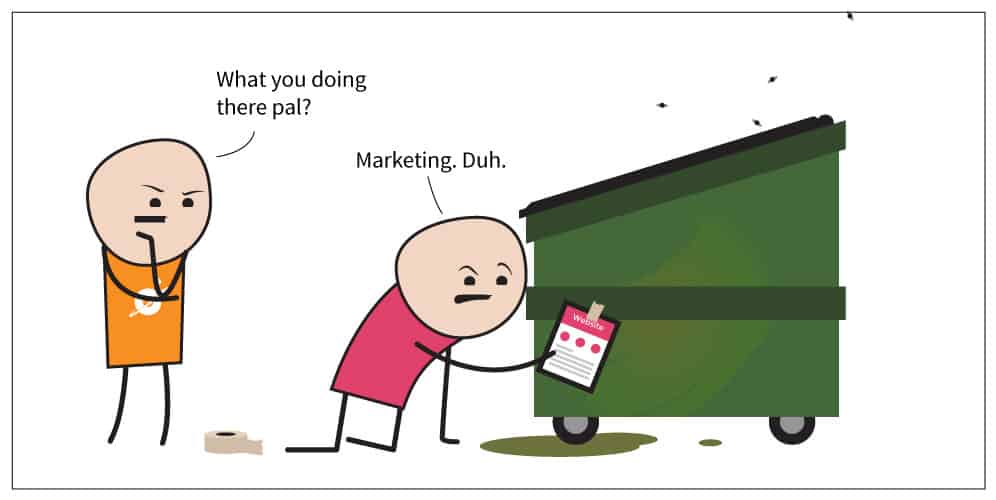
As cleverly explained by the cartoon, you can have the most creative and interesting website in the world, but if you market it horribly, then not many people will see it and you won’t get a very good return on your investment. OCG Creative’s team of dedicated and nerdy Reno web designers and developers work hard to produce these award winning sites. We have done this for numerous clients for many years. Part of the creative web design also involves the user’s experience with the website, which is why an analogy of a website being a poster is only part-true. In reality, a website is a fluid document – it changes with input from the user and looks different on different devices. OCG works to build the coolest website imaginable for our clients, but we know at the end of the day that it is essential to market it correctly, and websites should never stop when the design is completed.
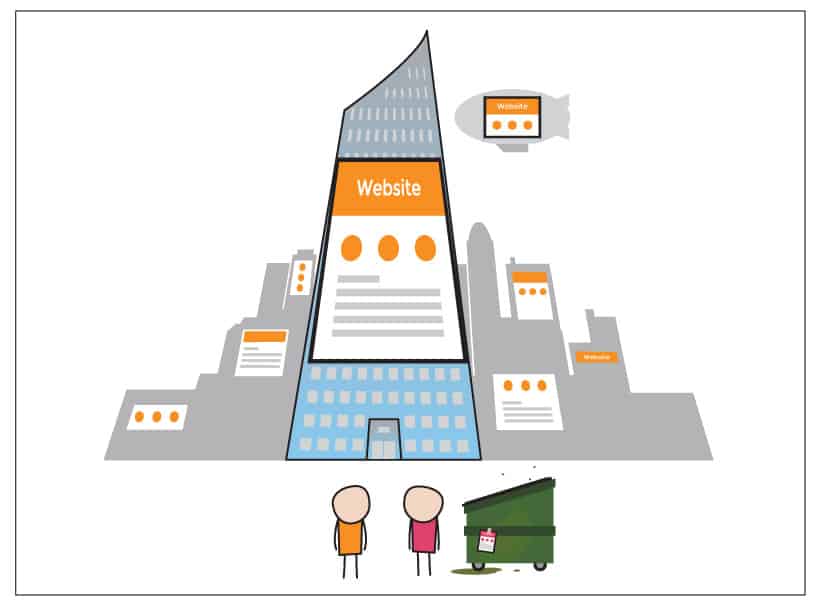
As a secret confession, I used to wonder this question all the time. There are plenty of online tools to build a website, and before I became a web designer, I even built my own portfolio using one of these tools. The issue with all of them… they’re awful. Even discounting the fact that all of them stop at the end of web design, the web design itself is clunky, confusing, and very limiting. I didn’t realize this until I experienced it first hand. A website should never stop at the end of creative web design. Instead, it should be a rocket-powered branding piece pushing the client forward to more exposure and spurring the start of a comprehensive effort to convert website visits into leads. OCG custom designs each website so it is beautiful and branded, but most importantly, they are scalable and sturdy for expansion in traffic and tailored to convert site visitors into customers.
After website design is completed, many people stop and never touch it again. It’s similar to making a cool poster and then never posting it anywhere. Why? Internet marketing takes effort, DIY site builders don’t have the resources to market each site created and the sites themselves are cluttered and reject efforts to market them. A lot of this is due to lack of on-site SEO support in addition to other elements such as effective landing pages and lack of Conversion Rate Optimization. It is much easier to stop after finishing the web design part.
The point is, OCG Creative is a dedicated and experienced Reno web design and internet marketing agency that has the resources. Websites should be built to be optimized for internet marketing. The issue with DIY site builders, is the website's inability to integrate with a meaningful and comprehensive marketing campaign for individual clients. This is because DIY sites purposefully exclude any means of integrating with an internet marketing plan, it is simply too much effort for DIY site builders to accommodate these features. Internet marketing takes time and a sturdy website foundation specifically built for internet marketing. Additionally DIY site builders don't want to manage campaigns because they take time and constant tuning. Hard work with SEO, Landing Pages, CRO, and other services, take time to gain traction. OCG maintains these campaigns, constantly tailoring our client’s Internet Marketing plans to coincide with optimal conversions including tracking page visits and valued keywords to get them ranking higher. You can’t get that level of detailed attention with do-it-yourself websites. It takes significant time, specialized data collection, and informed decisions to be implemented after data collection to market a website correctly.
If you’re not sure where to go from here knowing all of this or if you still think an awesome looking website is the most important thing for you or your business, give us a call or browse our other topics. We’ve been doing this for a while and know the internet marketing world front and back.
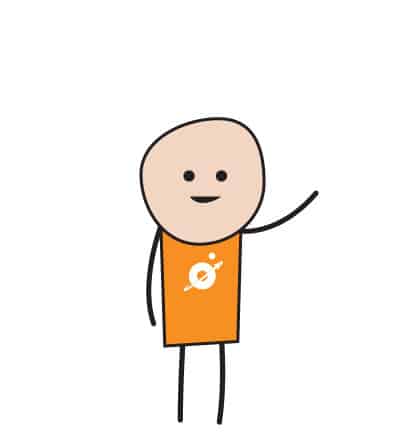
You might be surprised to know that online shopping, known to us now as e-commerce, first emerged at the tail end of the 1970s when inventor Michael Aldrich produced the first known electronic transaction system—a connection between an everyday television and a processing computer. Aldrich went on to develop more sophisticated tools for electronic transactions throughout the 1980s, which began to be adopted by large companies in the United Kingdom. Then in 1991, when Tim Berners Lee made his brainchild, the World Wide Web, available for public and commercial use, the electronic shopping systems that are ubiquitous today—including the shopping cart—began to take shape. IBM, e-Bay, and Amazon were some of the earliest to adopt and turn the technology into their core way of doing business. In the 25 years since then, the basic visual nature of the online shopping experience hasn’t changed much. But with mobile shopping firmly on scene and here to stay, digital storefronts and shopping carts seem to be undergoing a makeover. Here’s what some experts think you can expect to see for e-commerce in 2016: Increasingly standardized layouts This has been a trend in web design in general over the last couple of years, as developers and marketing departments are finding that standardizing their web sites translates into longer visit times and higher conversions. Users like to be comfortable and feel like they’re in familiar territory when they’re shopping. Get too out-of-the-box with your searches, CTAs, shopping carts, or other components of your pipeline and you create friction that can result in a dropped sale. That epiphany has led to standardizing of everything from menu delivery, button placement and design, and overall layouts— saving unique and creative ideas for the marketing campaign. Card-style product views You may have seen these popping up on retail web sites in recent months. Products are displayed in a self-contained, bite-sized card (also called tiles) that contains an image, a short description, the price, and, usually, links to share it on social media. Think: Pinterest. This presentation allows sellers to provide users with an at-a-glance view of the product that’s easy to compare with similar products in a way that’s visually rich but not overwhelming. Examples: https://www.behance.net https://canopy.co Flat, minimal, and vibrant Gone are the days of stylized, three-dimensional, deeply-shadowed objects layered throughout a single web page. We’ve been moving toward flatter design for many years, but the last two have seen a proliferation of these ultra-flat, minimal, image-driven e-commerce website designs. To offset that minimalism, designers are turning to bolder, chunkier typography and exceptional colorful (and sometimes unusual) tones.
Want to learn more about e-commerce? Check out our other articles!
We understand. When your web developer revealed your new website in 2004, it was love at first site. Your employees were excited, your clients were excited, business boomed, and you still look at it with affection every time you pull it up in the morning. It’s a beautiful but is also a slow website. Unfortunately, if it takes more than three seconds to fully load, and many websites with outmoded technology or development standards even just a few years old do, it’s costing you money. Consumers have become conditioned to hyper-fast load times, and are increasingly unwilling to wait more than a few seconds for websites that don’t provide them—an allowance that would have seemed ridiculous ten years ago. But today, 40% of web users say they’ll abandon a website if loading takes more than three seconds. Even more startling: Studies show that a delay of just one second on an e-commerce web site can reduce sales conversion rates by up to 7%. If your web site earns $25,000 per day, that’s a loss of $625,000 every year. Kissmetrics has a rundown of surprising stats on how un-optimized web page load time can effect your business. And isn’t just consumers giving your slow website the snub. Google, in service to demanding consumers, penalizes slow web sites in search rankings. Google’s model revolves around providing useful and easily-accessible information for its users. A slow-loading web site isn’t easily-accessible, and as such, isn’t considered useful. That means all the hard work you’ve put into boosting your SEO rankings could be deeply undermined by even a few seconds of delayed load time. A comprehensive web site with load times that meet modern standards should be at the top of your Internet marketing checklist. You can check your website’s page load times at Pingdom. Not cutting it at the three-second mark? Try these three adjustments to help bring those wait times down and get more visitors to stick around: 1. Optimize your images and videos. These are often the biggest culprit in older web sites. Most photo- and video-editing software has a “save for web," "quick export" or similar options that helps keep file size down. 2. Keep your script and CSS files compressed into a single file. If your Javascript is spread across several files that have to load every time a visitor refreshes your page, or clicks on another page in your website, your load times can plummet while the browser renders all of them. 3. Make smart use of caching. Caching allows the browser to keep certain elements of your website pre-loaded, so that when a visitor loads your page multiple times over a given timeframe, it doesn’t have the render the whole page from scratch each time. If after implementing those changes, your website is still loading too slowly, it’s time for a major tune-up.
Yesterday started out as an average busy afternoon, evenly spaced with quick yet heated discussions about Ender’s Game (movie and book), as well as, the “rumored” participation of the great Harrison Ford in the upcoming Star Wars Episode VII. Soon enough, said conversation abruptly sputtered out of control, down the proverbial rabbit hole that encompasses a geek's curiosity and need to discover hidden things on the interwebz (internet, for the nontechnical demographic out there).
I got what I thought was a “can you do something?” or worse yet a “did you do something?” request from Caroline, our wonderful SEO and many other talents guru (yes I am attempting to suck up). While oblivious to this request, Caroline so very politely reminded me to check my email. In my inbox yielded a message with the subject line “Can you figure this out?”.
So, what was this is all about?
Reno Startup Weekend is an event where “entrepreneurs come together and turn an idea into reality within 54 hours”. Later this month there will be a weekend full of events and competitions for entrepreneurs to bring their ideas, get mentored, launch startups and build products all at Reno Startup Weekend. The organization was posing a challenge to receive a discount for tickets to this year's event. A friend and colleague, Nicole- @nicolerosedion, from The Abbi Agency had been trying to get me to participate in this event for a couple of weeks now. I was familiar with the event and was well aware that I was running out of time to buy my ticket. Funny enough, Caroline found this challenge while Facebook-ing, I mean doing industry research. Though had I checked my text messages, I would of realized that Nicole already tried to clue me into the challenge earlier that day.
I followed the link and was greeted with this... “Things are not as they seem.” Well, that is all it took, I was hooked and sprang into action. Ah, the excitement and pressure as Caroline watched on clearly expecting a "Eureka!" 30 seconds after my quest began. Luckily this was not the case, so she left me to solve it on my own time and soon enough I had it!
I will tell you of the joy taking 15 minutes to doing something fun like this brought me. While I didn’t find this annoyingly challenging, it did force me to think outside the box and get creative to find the solution. This also reminded me that we should all take a few minutes a day to learn something new, using skills that we may not have to rely on everyday, or just do something challenging that's outside of your normal task flow. This will help to keep your creativity up and make the time you do spend being productive that much more valuable. With that rant, I hereby pass this challenge on to other any other developers and the curious who are up for the challenge. Take a few minutes out of your day to follow the white rabbit and be handsomely rewarded by not only the treasure at the end of the quest but by the enjoyment of taking a few minutes out of your routine to have some fun.
Read our other blog posts about entrepreneurs and business professionals.
I'm starting to feel like we're beating the same drum with back to back articles about WordPress, but the simple fact is that marketing with WordPress makes a lot of sense for most businesses of pretty much any size. It takes planning and effort, but of all the low cost ways to grow and market your business, writing blog articles can eat away at your competitor's market share in a way that is difficult, if not impossible, for them to compete with. It's hard to decide whether WordPress's incredible ability to reliably achieve top search rankings, or the ease by which site owners can manage their websites is the more valuable feature, but in my view search engines always win out over everything else. Not true in all situations, however. For a lot of business owners, providing a simple means of managing content is key. This is especially true for companies that use their websites to supply current information to an established user base. SEO may be be a factor in this case, but by no means most important. For most organizations, search engines rule. If you are selling a product or service, achieving top search engine rankings can mean the difference between success and failure. With WordPress, I've spent years experimenting with the right combination attributes and discovered that it is possible to achieve more or less real-time indexing of your website content. What this means is that, within minutes of your publishing an article (post or page), Google will have already added it to its search engine results page (SERP). I can't emphasize enough what realtime search indexing means to most businesses. By eliminating the normal crawl cycle, search engine marketers (as well as non-technical website owners or content managers) can get onto the SERP in a few minutes, a process that often takes 30 days or more--sometimes much more. Generally speaking, my list of top reasons business owners should consider WordPress is as follows...
All this sounds great, and it is. But, there are a few things for which WordPress may not be the best choice. Topping that list is large scale e-commerce. While there are many plugins (WooCommerce is one popular example) that make selling products possible, and even simple, none that I've worked with are ready for prime time. WordPress also may not be the best choice for websites that must present many varying types of data or content. For example, a site with several regions or feature areas on each type of page. To do this using WordPress, programmers often issue database calls to specific post categories or tags and display the result in the appropriate location on the webpage. It seems clever enough, but if you have a lot of them, things get out of hand pretty quickly. We've resolved the issue by doing unique things with custom post types, but there are times that a more traditional content management system (CMS) makes a better choice. This isn't so much of an issue here, but most web designers simply don't have the programming skills to do any serious custom work within the WordPress engine. As a result, many web designers install off the shelf themes and modify them. Many times, that's fine, but these modifications can be a nightmare if done improperly. For example, your website can be completely wiped out just by performing a routine update. Even with a few drawbacks, I'd say that 70% of the web development projects we do are custom WordPress websites. And, we are an engineering firm capable of building anything our clients dream up from scratch. If you've got questions about whether WordPress might be a good fit for your website project, drop me a note with a few details (joe@ocgcreative.com) and I'll be glad help you explore your options.
Unless you're in the business of designing websites, or your business is primarily e-commerce in nature, chances are you hate dealing with your website altogether. You're not alone, and there are plenty of good reasons. However, lots of business websites are bringing value to the businesses they to support, minus the frustrations. First, let's take a look at what those frustration points are then examine ways of avoiding them.
One of the key premises all business success is built upon is clear access to accurate information. With the web, however, everything seems shrouded in mystery. Endless technical barriers and other considerations act as barriers to keep the site owner from making clear decisions.
Some designers even use industry lingo and vague references as a smokescreen keep the business owner from engaging too directly. It's a dependency thing. If the web designer can keep the website owner convinced that any meaningful input should be left to "experts," the result is a measure of job security for the designer.
For you, the business owner insists that everything your web designer does can be justified in business terms that make sense. Our approach is to put in writing everything we do, and explain it in normal speaking language. We go further by empowering our clients to take control of their own websites, blogs, etc. We even provide a "nerd to human" decoder ring! Well, okay, I made that up, but we do make sure our website owners have the tools necessary to ensure their own success online.
This one's tough, even for us. Certain things take longer than expected. It's just one of the struggles, we as web developers must deal with. However, when you, the business website owner builds a strategy with the expectation that something will be finished on a certain date, that date is vitally important.
In our firm, we do two things. First, we track every minute spent on every task performed by every member of every project. As a result, we know how long things take. On top of that, we're so confident in our ability to estimate, that we offer our clients a no-risk guarantee. In other words, if we miss a deadline, you don't pay. So, when we say it'll be ready on Friday, you can be sure you'll have it on Friday, whatever "it" is.
The internet is a technical world, and only getting more so. It's just reality. As technologies evolve, business demands on how to best put the web to work evolve too. We love it. We love the challenges. We love the newness, and we love the idea that we're breaking through boundaries with each new project. But, when you're busy running a company, technical challenges can be very frustrating.
Our solution is to be as full service as our clients need. Often this means that we do it all. We are a team of strategists, analysts, engineers and artists. It is our job to keep you from having to deal with technical issues that take you away from running your business.
Perhaps the worst thing business owners have to put up with regarding their business websites, are snotty, condescending web designers. You know you just want to punch the little twerp, but you can't because next thing you know, your website will be promoting some unmentionable and it's only then that you learn he's holding your domain name for ransom.
While we confess a certain level of nerd-dom, we send the snotty geeks to seek employment elsewhere. The truth is, we don't like them either.
When it comes to CMS's I was strictly "old school" for years. I had it in my head that if you didn't "roll your own" you were somehow cheating the client by charging for code you didn't actually write. Maybe there was a bit of ego involved too. And, there's the fact the web was a completely different thing. Back then, the Internet was more or less a static world where we "hand-coders" would scoff at Dreamweaver (I still do), and pretty much anything that made doing web easy. After all, the Internet was new frontier where nerds ruled and the technical barriers were plentiful. The problem was that nerds generally turn up their noses at anything they haven't come up with themselves, or that wasn't handed down by some supreme nerd that has earned dominance by taking lesser nerds to some cyber-version of the coding woodshed. So, business workflows, marketing objectives and other economically valid reasons for a website's existence rarely factored into the design and development process. The site owner, basically would get what the programmer knew how to build--or wanted to build.
WordPress grew in popularity as a blogging engine. Being incredibly easy for non-technical people to learn and use, WordPress quickly earned its place as a standard bearer for what a blog engine should be. But, being a blog platform, site owners would (and still do) find themselves in need of features not natively included in the WordPress code base. For that, thousands of individual developers have been creating solutions, in the form of plugins, for years. A plugin is essentially an additional program that runs inside WordPress to make it do things like e-commerce, membership management, or whatever fits the needs of the site owner.
Plugins provide custom functionality. Themes provide the look. There are a couple thousand themes available on the WordPress site alone. Some are great, most are okay, and others, well, suck. The best WordPress themes are those that meet the requirements of the website without causing problems with the underlying code base, or lead to issues with other plugins or future updates. At our Reno web design company, we prefer to build themes from scratch although sometimes it isn't necessary or practical especially from a budgeting standpoint. When we work with third party themes, we always develop derivative themes, which in WordPress terms are called "child themes." Child themes insilate our code and modifications to the design from being overwritten by future updates.
Custom WordPress themes are themes we build entirely from the ground up. Building custom WordPress themes is very involved, requiring many hours of planning, design and development. An example of a custom WordPress theme we developed recently is Esteem Medical Spa & Salon. Esteem Medical Spa & Salon is a perfect example of why WordPress is so popular, and why we've grown to take WordPress development so seriously. As a Medical Spa, Esteem has a staff of very talented people who perform non-surgical treatment with exceptional results. Like most organizations, they should be focusing on their specialty service and not sifting through the technical nuances of website content management. When they came to us, they had a website with slow load times and poorly optimized pages for search. After proving our internet marketing capabilities they were more than happy to let us create a much better website experience.
The bottom line is WordPress is a very powerful content management tool when it comes to Reno web design. On the other hand, most WordPress websites are easy to spot since they tend to follow a similar structure. As mentioned earlier, custom WordPress development is complex; however, it is a solid choice of CMS for just about any business.